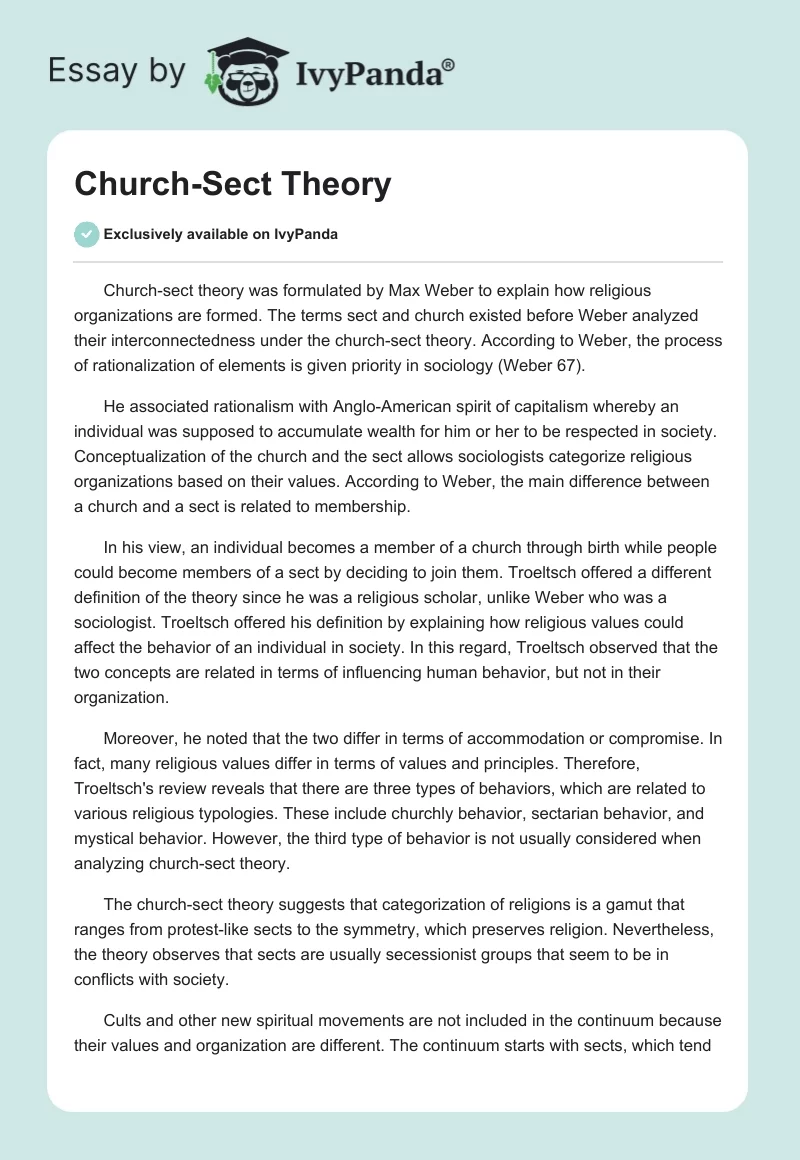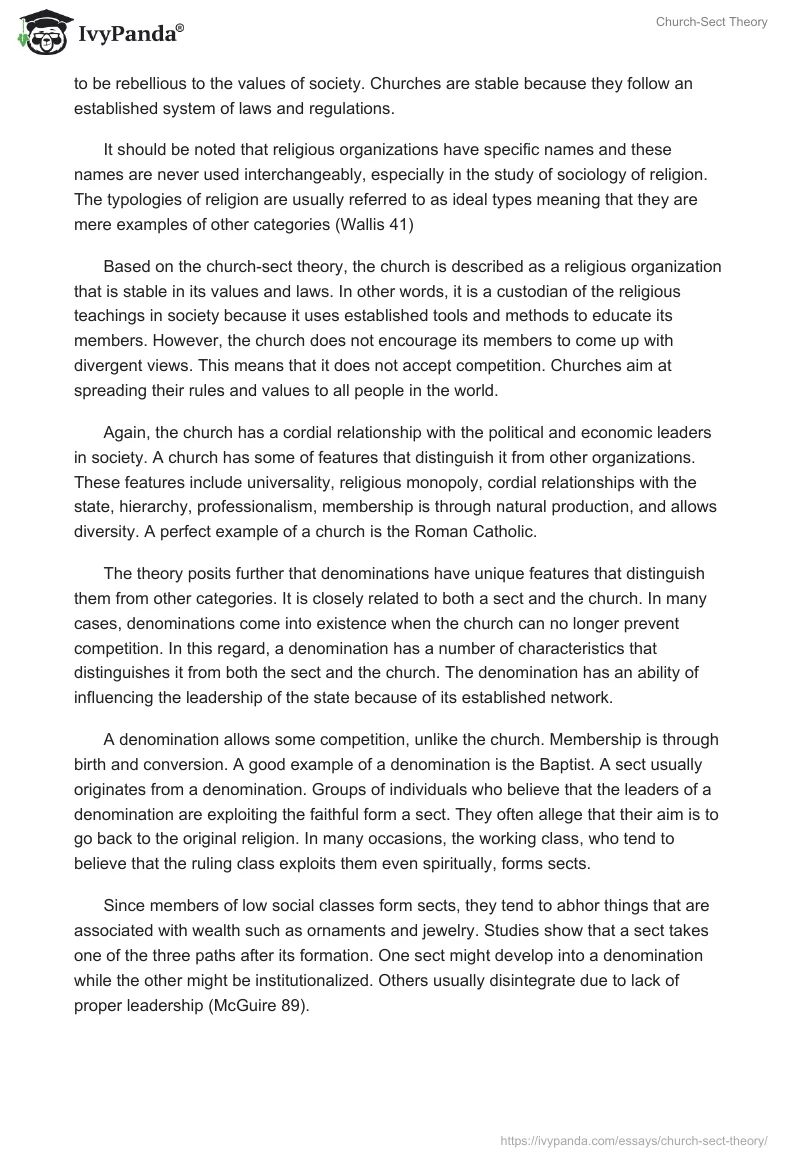Church-sect theory was formulated by Max Weber to explain how religious organizations are formed. The terms sect and church existed before Weber analyzed their interconnectedness under the church-sect theory. According to Weber, the process of rationalization of elements is given priority in sociology (Weber 67).
He associated rationalism with Anglo-American spirit of capitalism whereby an individual was supposed to accumulate wealth for him or her to be respected in society. Conceptualization of the church and the sect allows sociologists categorize religious organizations based on their values. According to Weber, the main difference between a church and a sect is related to membership.
In his view, an individual becomes a member of a church through birth while people could become members of a sect by deciding to join them. Troeltsch offered a different definition of the theory since he was a religious scholar, unlike Weber who was a sociologist. Troeltsch offered his definition by explaining how religious values could affect the behavior of an individual in society. In this regard, Troeltsch observed that the two concepts are related in terms of influencing human behavior, but not in their organization.
Moreover, he noted that the two differ in terms of accommodation or compromise. In fact, many religious values differ in terms of values and principles. Therefore, Troeltsch’s review reveals that there are three types of behaviors, which are related to various religious typologies. These include churchly behavior, sectarian behavior, and mystical behavior. However, the third type of behavior is not usually considered when analyzing church-sect theory.
The church-sect theory suggests that categorization of religions is a gamut that ranges from protest-like sects to the symmetry, which preserves religion. Nevertheless, the theory observes that sects are usually secessionist groups that seem to be in conflicts with society.
Cults and other new spiritual movements are not included in the continuum because their values and organization are different. The continuum starts with sects, which tend to be rebellious to the values of society. Churches are stable because they follow an established system of laws and regulations.
It should be noted that religious organizations have specific names and these names are never used interchangeably, especially in the study of sociology of religion. The typologies of religion are usually referred to as ideal types meaning that they are mere examples of other categories (Wallis 41)
Based on the church-sect theory, the church is described as a religious organization that is stable in its values and laws. In other words, it is a custodian of the religious teachings in society because it uses established tools and methods to educate its members. However, the church does not encourage its members to come up with divergent views. This means that it does not accept competition. Churches aim at spreading their rules and values to all people in the world.
Again, the church has a cordial relationship with the political and economic leaders in society. A church has some of features that distinguish it from other organizations. These features include universality, religious monopoly, cordial relationships with the state, hierarchy, professionalism, membership is through natural production, and allows diversity. A perfect example of a church is the Roman Catholic.
The theory posits further that denominations have unique features that distinguish them from other categories. It is closely related to both a sect and the church. In many cases, denominations come into existence when the church can no longer prevent competition. In this regard, a denomination has a number of characteristics that distinguishes it from both the sect and the church. The denomination has an ability of influencing the leadership of the state because of its established network.
A denomination allows some competition, unlike the church. Membership is through birth and conversion. A good example of a denomination is the Baptist. A sect usually originates from a denomination. Groups of individuals who believe that the leaders of a denomination are exploiting the faithful form a sect. They often allege that their aim is to go back to the original religion. In many occasions, the working class, who tend to believe that the ruling class exploits them even spiritually, forms sects.
Since members of low social classes form sects, they tend to abhor things that are associated with wealth such as ornaments and jewelry. Studies show that a sect takes one of the three paths after its formation. One sect might develop into a denomination while the other might be institutionalized. Others usually disintegrate due to lack of proper leadership (McGuire 89).
Religious Conflict
Inconsistencies in the church are evident in all parts of the world. It is noted that all religious groups experience conflicts. For instance, Hindu, Islam, Christianity, and other traditional religions have been faced with serious conflicts. A number of factors cause these conflicts. If some individuals tend to control the affairs of the church, conflicts would be inevitable. In India, the Hindu religion experienced conflicts because the son of the rajah tended to control the affairs of the mainstream religion.
The leader was accused of favoring his relatives in the appointment of priests. In China, a different religious belief referred to as Taoism emerged to oppose Confucianism mainly because of personal differences. In the bible, the apostles differed over some issues. For instance, the apostles of Jesus differed from the apostles of John over baptism.
The apostles of Jesus believed that baptism would convince the followers to embrace the teachings of the bible. For the apostles of John, they believed that an individual had to repent before being baptized. The apostles of Jesus believed that an individual had to believe before being baptized. This means that repentance and belief were the causes of disagreement (Settimba 21).
In the modern religion, there is an existing conflict between Roman Catholic and Protestantism. Catholic believes that people should be loyal to the church because the pope is the representative of Jesus Christ on earth. The central act of worship for Catholics is the Mass. Even though Protestantism concurs with Catholic over a number of teachings, the main conflict centers on the bible. Protestants believe in the New Testament and have four major convictions.
One of the beliefs is that an individual should relate directly with God as opposed to using priests. The Protestants believe that God is pursued individually instead of using priests. They believe that salvation is a personal issue meaning that a third party should not be involved in prayer.
On their part, Catholics believe that the priest is pure enough to help those in trouble during prayer. Moreover, the bible should be perceived as the word of God. Protestants observe that God works through miracles while Catholics do not believe in miracles.
Works Cited
McGuire, Meredith. Religion: the Social Context. New York: Sage, 2002. Print.
Settimba, Henry (2009). Testing times: globalization and investing theology in East Africa. Milton Keynes: Author House, 2009. Print.
Wallis, Roy. The Road to Total Freedom: a Sociological analysis of Scientology. Columbia: Columbia University Press, 1976. Print.
Weber, Max. The Protestant Ethic and the Spirit of Capitalism. Los Angeles: Roxbury Company, 2002. Print.


